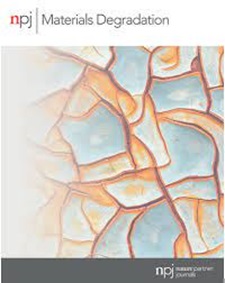矿物颗粒大小对Caballeronia mineralivorans PML1(12)风化矿物分子机制的反馈效应
IF 7.6
2区 材料科学
Q1 MATERIALS SCIENCE, MULTIDISCIPLINARY
引用次数: 0
摘要
细菌对矿物的溶解被认为取决于矿物性质、溶液化学和代谢的碳源。为了研究矿物粒度是否会影响风化的有效性以及细菌所采用的分子机制,我们考虑了菌株Caballeronia mineralivorans PML1(12)。通过微观实验和动力学实验,我们量化了黑云母溶解、细菌生长、铁载体生物合成和酸化的变化。通过使用不同的溶液化学成分、碳源和颗粒尺寸(从20到500微米),我们可以破译细菌酸化和螯合驱动的矿物风化的相对作用。结果显示,较小的颗粒(<100µm)溶解更快,强烈影响溶液化学和细菌生理,而较大的颗粒(>100µm)溶解更慢,更稳定,对细菌过程的影响最小。这些发现强调了颗粒大小对细菌溶解动力学和机制的影响和反馈效应。本文章由计算机程序翻译,如有差异,请以英文原文为准。

Feedback effect of the size of mineral particles on the molecular mechanisms employed by Caballeronia mineralivorans PML1(12) to weather minerals
Mineral dissolution by bacteria is thought to depend on mineral properties, solution chemistry, and the carbon sources metabolized. To investigate whether mineral particle size could impact the effectiveness of weathering and the molecular mechanisms employed by bacteria, the strain Caballeronia mineralivorans PML1(12) was considered. Through microcosm and kinetic experiments, we quantified changes in biotite dissolution, bacterial growth, siderophore biosynthesis, and acidification. The use of different solution chemistries, carbon sources, and particle sizes (from <20 to 500 µm) allowed us to decipher the relative role of acidification- and chelation-driven mineral weathering by bacteria. Results revealed a faster dissolution for smaller particles (<100 µm) that strongly affected both solution chemistry and bacterial physiology, while larger particles (>100 µm) showed a slower and steady dissolution with minimal impact on bacterial processes. These findings underscore the influence and feedback effects of particle size on the dynamics of dissolution and the mechanisms employed by bacteria.
求助全文
通过发布文献求助,成功后即可免费获取论文全文。
去求助
来源期刊

npj Materials Degradation
MATERIALS SCIENCE, MULTIDISCIPLINARY-
CiteScore
7.80
自引率
7.80%
发文量
86
审稿时长
6 weeks
期刊介绍:
npj Materials Degradation considers basic and applied research that explores all aspects of the degradation of metallic and non-metallic materials. The journal broadly defines ‘materials degradation’ as a reduction in the ability of a material to perform its task in-service as a result of environmental exposure.
The journal covers a broad range of topics including but not limited to:
-Degradation of metals, glasses, minerals, polymers, ceramics, cements and composites in natural and engineered environments, as a result of various stimuli
-Computational and experimental studies of degradation mechanisms and kinetics
-Characterization of degradation by traditional and emerging techniques
-New approaches and technologies for enhancing resistance to degradation
-Inspection and monitoring techniques for materials in-service, such as sensing technologies
 求助内容:
求助内容: 应助结果提醒方式:
应助结果提醒方式:


